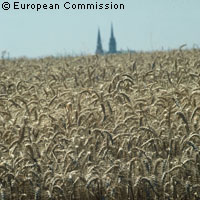Turkish wheat varieties resistant to stripe rust fungus, study finds
Turkish winter wheat varieties have a gene that makes them resistant to a fungal disease called stripe rust. The gene remains effective even under UK conditions, a study conducted by Turkish and British researchers at the Norwich-based John Innes Centre (JIC) suggests. The study investigated 100 Turkish winter wheat varieties - selected from different breeding programmes across Turkey and into Kazakhstan - and 31 European wheat strains, representing the last eight decades of wheat breeding in Europe. Both, Turkish and European strains were assessed for resistance to eight different stripe rust isolates at the seedling growth stage and also examined for infection in the field. The tests showed that many Turkish wheat varieties still carried seedling resistance. Furthermore, while European wheats turned out to be susceptible to the endemic UK stripe rust, the majority of Turkish varieties were still resistant. Results of DNA screening further indicate that the Turkish resistance gene is distinct from resistance genes common in European wheat varieties. It might thus be a valuable source of new resistances that could be introduced into varieties for European agriculture. 'However, the high level of seedling resistance still present in these Turkish varieties makes one cautious, as some of the stripe rust resistance may be race-specific in nature,' the final report points out. If this is the case, 'it is only a matter of time before the resistance is overcome in the field.' Stripe rust - also known as yellow rust - is caused by fungi called Puccinia striiformis, and affects barley, rye, wheat and numerous perennial grass species. Infections produce linear, orange-yellow pustules on leaves and/or heads that coalesce to form long stripes between leaf veins as the disease progresses. The disease spreads quickly from small loci of infection in the field. It thrives in cool and wet climates, causing losses of up to 40%. The BESTWheats project was carried out as part of the Marie-Curie actions Intra-European fellowships. This allowed Turkish researcher Professor Muge Sayar from the Bogazici University in Istanbul to spend 12 months at the JIC in Norwich. Under the supervision of project coordinator Dr Lesley Ann Boyd from the JIC, the project aimed to improve collaboration between Turkish and European cereal breeders. It received around ¿86,000 funding under the EU's Sixth Framework Programme (FP6).
Countries
Türkiye



